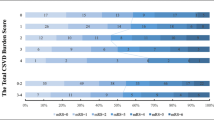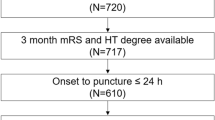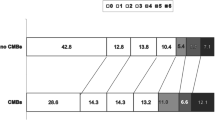Abstract
Background and purpose
In patients with acute ischemic stroke (AIS) treated with endovascular therapy (EVT), the association of pre-existing cerebral small vessel disease (cSVD) with symptomatic intracerebral hemorrhage (sICH) remains controversial. We tested the hypothesis that the presence of cerebral microbleeds (CMBs) and their burden would be associated with sICH after EVT of AIS.
Methods
We conducted a retrospective study combining cohorts of patients that underwent EVT between January 1st 2015 and January 1st 2020. CMB presence, burden, and other cSVD markers were assessed on a pre-treatment MRI, evaluated independently by two observers. Primary outcome was the occurrence of sICH.
Results
445 patients with pretreatment MRI were included, of which 70 (15.7%) demonstrated CMBs on baseline MRI. sICH occurred in 36 (7.6%) of all patients. Univariate analysis did not demonstrate an association between CMB and the occurrence of sICH (7.5% in CMB+ group vs 8.6% in CMB group, p = 0.805). In multivariable models, CMBs’ presence was not significantly associated with increased odds for sICH (-aOR- 1.19; 95% CI [0.43–3.27], p = 0.73). Only ASPECTs (aOR 0.71 per point increase; 95% CI [0.60–0.85], p < 0.001) and collaterals status (aOR 0.22 for adequate versus poor collaterals; 95% CI [0.06–0.93], p 0.019) were independently associated with sICH.
Conclusion
CMB presence and burden is not associated with increased occurrence of sICH after EVT. This result incites not to exclude patients with CMBs from EVT. The risk of sICH after EVT in patients with more than10 CMBs will require further investigation.
Registration
Registration-URL: http://www.clinicaltrials.gov; Unique identifier: NCT01062698.

Similar content being viewed by others
Data availability
Data from this cohort shall be made available upon reasonable request by a qualified investigator to the corresponding author and after clearance by the local ethics committee.
Abbreviations
- AIS:
-
Acute ischemic stroke
- aOR:
-
Adjusted odds ratio
- ASPECT:
-
Alberta Stroke Program Early CT
- CMB:
-
Cerebral microbleeds
- cSVD:
-
Cerebral small vessel disease
- LVO:
-
Large vessel occlusion
- mRS:
-
Modified Rankin scale
- EVT:
-
Endovascular treatment
- THRACE:
-
THRombectomie des Arteres CErebrales
- WMH:
-
White matter hyperintensity
- HT:
-
Hemorrhagic transformation
References
Yaghi S, Willey JZ, Cucchiara B et al (2017) Treatment and outcome of hemorrhagic transformation after intravenous alteplase in acute ischemic stroke: a scientific statement for healthcare Professionals From the American Heart Association/American Stroke Association. Stroke 48:e343–e361. https://doi.org/10.1161/STR.0000000000000152
Kaesmacher J, Kaesmacher M, Maegerlein C et al (2017) Hemorrhagic transformations after thrombectomy: risk factors and clinical relevance. Cerebrovasc Dis Basel Switz 43:294–304. https://doi.org/10.1159/000460265
Whiteley WN, Slot KB, Fernandes P et al (2012) Risk factors for intracranial hemorrhage in acute ischemic stroke patients treated with recombinant tissue plasminogen activator: a systematic review and meta-analysis of 55 studies. Stroke 43:2904–2909. https://doi.org/10.1161/STROKEAHA.112.665331
Wen L, Zhang S, Wan K et al (2020) Risk factors of haemorrhagic transformation for acute ischaemic stroke in Chinese patients receiving intravenous thrombolysis. Med (Baltim) 99:e18995. https://doi.org/10.1097/MD.0000000000018995
Goyal M, Menon BK, van Zwam WH et al (2016) Endovascular thrombectomy after large-vessel ischaemic stroke: a meta-analysis of individual patient data from five randomised trials. The Lancet 387:1723–1731. https://doi.org/10.1016/S0140-6736(16)00163-X
Derraz I, Cagnazzo F, Gaillard N et al (2021) Microbleeds, cerebral hemorrhage, and functional outcome after endovascular thrombectomy. Neurology 96:e1724–e1731. https://doi.org/10.1212/WNL.0000000000011566
Shi Z-S, Duckwiler GR, Jahan R et al (2016) Mechanical thrombectomy for acute ischemic stroke with cerebral microbleeds. J Neurointerventional Surg 8:563–567. https://doi.org/10.1136/neurintsurg-2015-011765
Wu X, Yan J, Ye H et al (2020) Pre-treatment cerebral microbleeds and intracranial hemorrhage in patients with ischemic stroke receiving endovascular therapy: a systematic review and meta-analysis. J Neurol 267:1227–1232. https://doi.org/10.1007/s00415-019-09210-6
Montalvo M, Mistry E, Chang AD et al (2019) Predicting symptomatic intracranial haemorrhage after mechanical thrombectomy: the TAG score. J Neurol Neurosurg Psychiatry 90:1370–1374. https://doi.org/10.1136/jnnp-2019-321184
Zhang X, Xie Y, Wang H et al (2020) Symptomatic intracranial hemorrhage after mechanical thrombectomy in chinese ischemic stroke patients: the ASIAN score. Stroke 51:2690–2696. https://doi.org/10.1161/STROKEAHA.120.030173
Yan S, Jin X, Zhang X et al (2015) Extensive cerebral microbleeds predict parenchymal haemorrhage and poor outcome after intravenous thrombolysis. J Neurol Neurosurg Psychiatry 86:1267–1272. https://doi.org/10.1136/jnnp-2014-309857
Charidimou A, Shoamanesh A, Wilson D et al (2015) Cerebral microbleeds and postthrombolysis intracerebral hemorrhage risk Updated meta-analysis. Neurology 85:927–924. https://doi.org/10.1212/WNL.0000000000001923
Tsivgoulis G, Zand R, Katsanos AH et al (2016) Risk of symptomatic intracerebral hemorrhage after intravenous thrombolysis in patients with acute ischemic stroke and high cerebral microbleed burden: a meta-analysis. JAMA Neurol 73:675–683. https://doi.org/10.1001/jamaneurol.2016.0292
Charidimou A, Turc G, Oppenheim C et al (2017) Microbleeds, cerebral hemorrhage, and functional outcome after stroke thrombolysis. Stroke 48:2084–2090. https://doi.org/10.1161/STROKEAHA.116.012992
Bracard S, Ducrocq X, Mas JL et al (2016) Mechanical thrombectomy after intravenous alteplase versus alteplase alone after stroke (THRACE): a randomised controlled trial. Lancet Neurol 15:1138–1147. https://doi.org/10.1016/S1474-4422(16)30177-6
Wardlaw JM, Smith EE, Biessels GJ et al (2013) Neuroimaging standards for research into small vessel disease and its contribution to ageing and neurodegeneration. Lancet Neurol 12:822–838. https://doi.org/10.1016/S1474-4422(13)70124-8
Staals J, Makin SDJ, Doubal FN et al (2014) Stroke subtype, vascular risk factors, and total MRI brain small-vessel disease burden. Neurology 83:1228–1234. https://doi.org/10.1212/WNL.0000000000000837
Amin Al Olama A, Wason JMS, Tuladhar AM et al (2020) Simple MRI score aids prediction of dementia in cerebral small vessel disease. Neurology 94:e1294–e1302. https://doi.org/10.1212/WNL.0000000000009141
Liebeskind DS, Tomsick TA, Foster LD et al (2014) Collaterals at angiography and outcomes in the interventional management of stroke (IMS) III trial. Stroke 45:759–764. https://doi.org/10.1161/STROKEAHA.113.004072
Hacke W, Kaste M, Fieschi C et al (1998) Randomised double-blind placebo-controlled trial of thrombolytic therapy with intravenous alteplase in acute ischaemic stroke (ECASS II). Second European-Australasian Acute Stroke Study Investigators. Lancet Lond Engl 352:1245–1251. https://doi.org/10.1016/s0140-6736(98)08020-9
Hacke W, Kaste M, Bluhmki E et al (2008) Thrombolysis with alteplase 3 to 4.5 hours after acute ischemic stroke. N Engl J Med 359:1317–1329. https://doi.org/10.1056/NEJMoa0804656
von Elm E, Altman DG, Egger M et al (2007) The Strengthening the Reporting of Observational Studies in Epidemiology (STROBE) statement: guidelines for reporting observational studies. The Lancet 370:1453–1457. https://doi.org/10.1016/S0140-6736(07)61602-X
Choi K-H, Kim J-H, Kang K-W et al (2019) Impact of microbleeds on outcome following recanalization in patients with acute ischemic stroke. Stroke 50:127–134. https://doi.org/10.1161/STROKEAHA.118.023084
Diedler J, Ahmed N, Sykora M et al (2010) Safety of intravenous thrombolysis for acute ischemic stroke in patients receiving antiplatelet therapy at stroke onset. Stroke 41:288–294. https://doi.org/10.1161/STROKEAHA.109.559724
Luo S, Zhuang M, Zeng W, Tao J (2016) Intravenous thrombolysis for acute ischemic stroke in patients receiving antiplatelet therapy: a systematic review and meta-analysis of 19 studies. J Am Heart Assoc 5:e003242. https://doi.org/10.1161/JAHA.116.003242
Karaszewski B, Houlden H, Smith EE et al (2015) What causes intracerebral bleeding after thrombolysis for acute ischaemic stroke? Recent insights into mechanisms and potential biomarkers. J Neurol Neurosurg Psychiatry 86:1127–1136. https://doi.org/10.1136/jnnp-2014-309705
De Guio F, Jouvent E, Biessels GJ et al (2016) Reproducibility and variability of quantitative magnetic resonance imaging markers in cerebral small vessel disease. J Cereb Blood Flow Metab Off J Int Soc Cereb Blood Flow Metab 36:1319–1337. https://doi.org/10.1177/0271678X16647396
Acknowledgements
None.
Funding
None.
Author information
Authors and Affiliations
Corresponding author
Ethics declarations
Competing interests
None.
Rights and permissions
Springer Nature or its licensor (e.g. a society or other partner) holds exclusive rights to this article under a publishing agreement with the author(s) or other rightsholder(s); author self-archiving of the accepted manuscript version of this article is solely governed by the terms of such publishing agreement and applicable law.
About this article
Cite this article
Agbonon, R., Forestier, G., Bricout, N. et al. Cerebral microbleeds and risk of symptomatic hemorrhagic transformation following mechanical thrombectomy for large vessel ischemic stroke. J Neurol 271, 2631–2638 (2024). https://doi.org/10.1007/s00415-024-12205-7
Received:
Revised:
Accepted:
Published:
Issue Date:
DOI: https://doi.org/10.1007/s00415-024-12205-7




